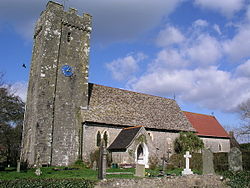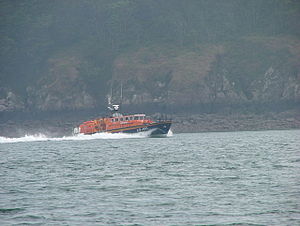Angle
| Angle | |
| Pembrokeshire | |
|---|---|
 Angle Church | |
| Location | |
| Grid reference: | SM8602 |
| Location: | 51°41’5"N, 5°5’31"W |
| Data | |
| Post town: | Pembroke |
| Postcode: | SA71 |
| Dialling code: | 01646 |
| Local Government | |
| Council: | Pembrokeshire |
| Parliamentary constituency: |
Carmarthen West and South Pembrokeshire |
Angle is a village and parish located on a narrow peninsula on the very south-west tip of Pembrokeshire. It has two public houses, a school, post office, a castle, St Mary's church[1] and a sandy beach to the west of the village. The nearest railway station is Pembroke, from where there is a bus link. The Angle lifeboat received silver medals in 1878[2] for rescuing the crew of the Loch Shiel from rocks near Thorn Island. The ship had been carrying a cargo of whisky and beer.[3]
Contents
The village
A major occupation is tourism as people travel to use the sheltered beach at West Angle Bay, which has been designated a Site of Special Scientific Interest. The rockpools in the bay are home to a small green starfish called Asterina phylactica.[4] The starfish was only formally identified in 1979.[5]
The "castle" in the village is a single pele tower that was built by Robert de Shirburn in the 14th century.[6] It is within Castle Farm but can be easily accessed. The castle may have been built by the Shirburn family during the time of Owain Glyndŵr. A French army landed at Angle in 1405 to assist Glyndŵr. Some sources see the castle as a simple pele tower but others see evidence of a moat and another tower and regard what survives as being the remains of a larger castle.[7]
In the nineteenth century it was reported that 388 people lived in the village with the women involved in plaiting straw for bonnets and mats, whilst the men would trawl for oysters when they were in season.[1]
In the same century a large number of forts were constructed around Pembroke Dock and Milford Haven. Three of these are on the coast around Angle: the East Blockhouse Battery, Thorn Island Fort, and the Chapel Bay Fort. Their construction was at the behest of Lord Palmerston following the Royal Commission on the Defence of the United Kingdom.
For many generations the chief landowners in Angle were the Mirehouse family,[8] descendants of John Mirehouse of Brownslade, Pembrokeshire, who purchased the Angle estate from the Kinner family for £29,000 shortly after 1800.[9] The family later made The Hall its main seat after extensive refurbishment in the 1830s.[10] By 1886, John Mirehouse's descendant, Lt. Col. Richard Walter Byrd Levett of Staffordshire, graduate of Eton College and Christ Church, Oxford, had taken the surname of his mother's family and had settled in the village.[11]
Lt. Col. Mirehouse, as he became known, lived at The Hall, Angle, where his descendants continue to live today, and where he embarked on making improvements to the estate and the village, including constructing a number of buildings, including the eclectic Globe Hotel, now in private hands. The Mirehouse estate included Cheveralton Farm and Hubberton Farm. The family also owned the Golden Estate in Pembroke and Wallaston Farm in Pembroke St. Mary.[12] John Mirehouse was appointed High Sheriff of Pembrokeshire in 1831, and Lt. Col. Richard Walter Byrd Mirehouse served as High Sheriff in 1886.[13]
St. Mary's church
The church stands in the main street surrounded by a full graveyard and more unusually a seaman's chapel, which is dedicated to St. Anthony.[14] The chapel is a fairly small building that was built in the 15th century (1447) by Edward de Shirburn a "knight of Nangle". Beneath the chapel is a crypt where many anonymous seamen's bodies that had been found on the coastline were readied for burial until the early twentieth century.[14]
The church itself is thought to have been built in the thirteenth century with the tower added in the fifteenth century. The church's grounds also include a number of graves for a Japanese ship that sank locally during the First World War.[14] The church contains memorials to the Mirehouse family of The Hall, Angle, as well as ancient monuments to the families of Ferrers and Dawes of Bangeston, now a ruin located within the parish.
Notable residents
- Lieut-Col Richard W.B. Mirehouse (1849–1914) High Sheriff of Pembrokeshire, 1886, and Lieutenant Colonel of 4th Batt. North Staffs Regiment.[15][16]
- Jocelyn de Angulo, ancestor of the Nagle and Costello families of Ireland, fl. 1172
Lifeboat
A lifeboat station was established here in 1868; since then there have been a number of lifeboats and even a number of different slipways. The crew here has received numerous awards including seven silver medals from the RNLI.[2] In 2008 there are two lifeboats, The Lady Rank and the smaller Richard John Talbot Miller.
The first rescue where the crew received silver medals was in the rescue of 27[2] (some say 33[17]) people who were on board the 1878-built Loch Shiel which had run into rocks off Thorn Island. Two lifeboat crew members and the honorary secretary received silver medals. One of these crew members was Thomas Rees. He is buried in the church yard at St Mary's. It was said that the lifeboat was unable to reach them but these brave people managed to get to them by climbing around Thorn island and getting a rope to the ship. They literally held on by their finger tips to achieve this.
The rescue is particularly noteworthy as it is described as Wales' "Whisky Galore". The Loch Shiel was carrying goods from Scotland to Adelaide and included gunpowder, beer[18] and 7,500[3] (some say 7,000[17]) cases of Glasgow whisky. Much of this was never recovered. Some of the bottles are still amongst the wreck which are described as "undrinkable", but much of the cargo was only partially recovered by the customs men.[17] It was said that one local drank himself to death on the 100 proof whiskey.[18] In 1999, bottles of beer from the wreck were auctioned for £1,000 per bottle.[3]
The next award was a bronze medal awarded to Coxswain James Watkins for rescuing 28 people on the 26 November 1929 from the single-screw steamship Molesley which had been caught by a sudden wind change and a poor decision by its captain.[19] James Watkins went on to be awarded both a silver medal for rescuing 6 people in 1944 from the motor boat Thor and a year later another bronze medal for a difficult rescue of nine people from the steamer .[2] (This steamer had been seized from the Germans and sank on the 15 July before it could be renamed the Empire Concourse.[20])
More recently, Coxswain William John Rees Holmes has been awarded two bronze medals. The first was in 1977 when the tanker Donna Marike was thought to be about to explode and the lifeboat stood by her in December 1976. The second bronze medal was for rescuing three people from the fishing boat Cairnsmore on 1 December 1978.[2]
In 1997 a third coxswain, Jeremy R. Rees, and his crew were awarded another bronze medal for rescuing four people after their motor boat, Dale Princess, was blown onto cliffs on Skomer Island. The rescue was made in gale force winds and stormy seas.[2]
In April 2009, a new £2.2m Tamar-class lifeboat replaced the previous Tyne class boat. Funding raising started in 2006 in Pembrokeshire and Birmingham, while a single £1.6m donation from Grand Lodge of Mark Master Masons, a branch of the Free Masons in London, enabled final purchase of the boat.[21][22]
Recent events
In 1996, the coastline around Angle was severely affected by an oil spill from the Sea Empress. The eventual cleanup of all the beaches took several years and cost £60 million.[23]
References
| ("Wikimedia Commons" has material about Angle) |
- ↑ 1.0 1.1 A Topographical Dictionary of Wales, S. Lewis,, 1844, Genuki, accessed 30 August 2008
- ↑ 2.0 2.1 2.2 2.3 2.4 2.5 Angle History, RNLI.org, accessed 30 August 2008<
- ↑ 3.0 3.1 3.2 Diver sinks £1,000 pint, BBC, accessed 30 August 2008
- ↑ Angle, VisitPembrokeshire.com, accessed 30 August 2008
- ↑ Asterina phylactica, habitas.org.uk, accessed 31 August 2008
- ↑ Angle Castle, Castles of Britain, accessed 30 August 2008
- ↑ Welsh Castles: A Guide by Counties, Adrian Pettifer, 2000, ISBN 0-85115-778-5
- ↑ The son of John Mirehouse who purchased the Angle estate married the daughter of the Rev. Dr John Fisher, patron of painter John Constable.[1]
- ↑ John Mirehouse, an agent for John Campbell, 1st Baron Cawdor, first lived in a home built for him at Brownslade by William Thomas, a protege of Lord Cawdor.[2]
- ↑ Angle Estate Papers, Allen-Mirehouse Family of Angle, Pembrokeshire Record Office
- ↑ The Plantagenet Roll of the Blood Royal: The Mortimer-Percy Volume, Marquis of Ruvigny, Reprinted by Heritage Books, 2001, ISBN 0-7884-1872-6, ISBN 978-0-7884-1872-3
- ↑ Angle, Pembrokeshire, Genuki.org
- ↑ Visitation of England and Wales, Vol. 3, Joseph Jackson Howard, Frederick Arthur Crisp, The College of Arms, Privately Printed, London, 1895
- ↑ 14.0 14.1 14.2 The Benefice, Rev. Jones, accessed 30 August 2008
- ↑ ‘MIREHOUSE, Lieut-Col Richard Walter Byrd’, Who Was Who, A & C Black, 1920–2007; online edn, Oxford University Press, Dec 2007 accessed 30 Aug 2008
- ↑ Richard Mirehouse, formerly Levett, The Eton Register, Part III, Old Etonian Association, Spottiswoode & Co., Eton, 1906
- ↑ 17.0 17.1 17.2 letters, wrecksite.eu, accessed 30 August 2008
- ↑ 18.0 18.1 Loch Liel, Pembrokeshire wrecks
- ↑ Wreck report for Molesley, 19 August 1930, GB Board of Trade
- ↑ EMPIRE - C, mariners-l.co.uk
- ↑ http://www.anglelifeboat.org/news%20page.htm
- ↑ http://www.westerntelegraph.co.uk/news/4211993.Angle_welcomes_new_Tamar_lifeboat/
- ↑ BBC Wales On Air:Sea Empress

